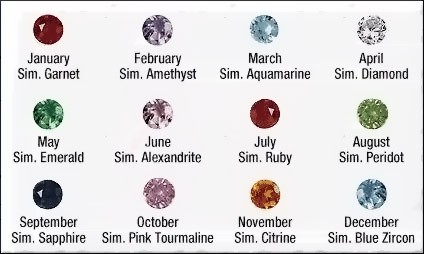| Styles of Diamond Cuts | |
| Round Brilliant: The most common style of cutting both diamonds and colored stones. The standard round brilliant consists of 57 facets; 1 table, 8 bezel facets, 8 star facets 16 upper-girdle facets on the crown; 8 pavilion facets, 16 lower girdle facets; and usually a culet on the pavilion. Modifications of the round brilliant include such fancy shapes as the marquise, half moon, pear shape and many others. | |
 |
Pear: A variation of the Brilliant cut, combining the Round and Marquise cuts, with 58 facets to only 56 facets (when the pavilion facets at the head and tail are eliminated). Shoulders should have a gently but distinctly rounded arch. Common length-to-width ratio: 1 to 1.50-1.75. |
 |
Oval: A brilliant style of cutting very similar to a Round except it is elliptical. It was invented by Lazare Kaplan in the early 1960s. Oval brilliant usually has 56 or 57 facets. Beware of uneven or high shoulders (they should have a gently but distinctly rounded arch). Typical length-to-width ratio: 1 to 1.30-1.65. |
 |
Marquise: This shape has a boat shaped girdle with 57 facets. The shape and placement of the facets is of the brilliant type. The name "Marquise" came from a legend of the Marquise of Pompadour that the Sun King wanted a Diamond to be polished into the shape of the mouth of the Marquise. Look for uneven "wings" or undefined points. Typical length-to-width ratio: 1 to 1.75-2.25. |
 |
Emerald: A form of step cutting. It is usually rectangular but sometimes may be square, in which case it is known as a square emerald cut. It has rows (steps) of elongated facets on the crown and pavilion, parallel to the girdle, and with corner facets. The number of rows of elongated facets may vary, although the usual number is three on the crown and three on the pavilion. Inclusions are slightly more visible in "step-cut" shapes relative to "brilliant styles. Look for too narrow or missing corners. The beveled corners protect the stone and make it easier to set. Typical length-to-width ratio: 1 to 1.30-1.70. |
|
|
Princess (also the patented Quadrillion): Is a relatively new shape and generally has 70 to 76 facets (no culet). Normally it is close to a square shape (+ or - 10%), but may come in elongated versions. Watch out for girdles which are extremely thin and thus prone to chipping. Typical length-to-width ratio: 1 to 1.00-1.10. |
|
|
Radiant: Rectangular or square stone with cut corners. The original patented cut has 70 facets but it is readily available in modified versions with 62 to 70 facets. Typical length-to-width ratio: 1 to 1.20-1.50 for the rectangular stones. |
 |
Heart: Look for uneven or flat "wings" or too shallow cleft. Typical length-to-width ratio: 1 to 0.90-1.10. |
|
|
Trillion (or: Trilliant, trielle): Popular choice for side-diamonds to enhance center diamond. Typical length-to-width ratio: 1 to 0.90-1.10. |
 |
Cushion: Evolved from the 'Old Mine Cut' that was developed before the turn of the century. It is square to rectangular cut with rounded corners and 58 facets and is characteristically with large facets, depth, and an open cutlet (the tip on the bottom of the diamond). |
| Birth Stones |
For more info Contact Thomas or T.J. Denton Email tdentonco1412@sbcglobal.net or Phone 818-247-1172 |
 |